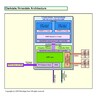Intel Core 2 Duo SP9600 vs Intel Core i5-540M vs Intel Core 2 Duo SL9380
Intel Core 2 Duo SP9600
► remove from comparison
Der Intel Core 2 Duo SP9600 ist ein sparsamer High-End Dual Core Prozessor für flache Notebooks. Er basiert auf dem Core 2 Duo P9500, wird jedoch nur in BGA (Ball Grid Array) Ausführung angeboten zum direkten Auflöten auf das Mainboard. Dadurch ist die Package Größe des Prozessors auch deutlich geringer (22m2 versus 35mm2 beim P9500). Der SP9600 kann dadurch in sehr flachen aber trotzdem leistungsstarken Notebooks eingesetzt werden (z.B. Lenovo Thinkpad T400s). Der Stromverbrauch von max. 25 W TDP ist jedoch identisch
Die Performance des Core 2 Duo SP9600 ist vergleichbar mit dem ebenfalls mit 2.53 GHz getakteten Core 2 Duo T9400 und dadurch sollte sie für die meisten Spiele in 2009 ausreichen (nur GTA 4 profitiert deutlich von mehr Prozessorkernen oder höherem Takt). Der alte Core 2 Quad Q9000 wird auch bei den meisten Anwendungen geschlagen, da er mit nur 2.0 GHz getaktet wird.
Der Penryn (Montevina Update) Kern bietet 2 Integer Units, 1 Floating Point Unit, 1 Load Unit und 1 Store Unit in einer 14-stufigen Pipeline. Mit der Wide Dynamic Execution Technologie kann der Kern bis zu vier volle Instruktionen gleichzeitig ausführen.
Intel Core i5-540M
► remove from comparison
Der Intel Core i5-540M ist ein zwei-Kern Prozessor für Notebooks und taktet dank Turbo mit 2.53 - 3.06 GHz. Die zwei Kerne basiert auf die Nehalem (Westmere) Mikro-Architektur und können dank Hyperthreading 4 Threads gleichzeitig abarbeiten.
Eine Besonderheit der neuen Dual-Core CPUs von Intel ist die Integration des Speichercontrollers und einer integrierten Grafikkarte (GMA HD) in das Package. Die CPU wird bereits in 32nm hergestellt, der Die für den Speichercontroller und die Grafikkarte jedoch noch in 45nm.
Die Performance des i5-540M liegt dank Turbo Boost im Schnitt oberhalb eines 2.8 GHz getakteten Core 2 Duo (z.B. P9700) und daher zählt der Core-i5 zu den schnellsten Dual-Core CPUs in 2010. Dank HyperThreading kann der 540M sogar langsam getaktete Quad Core CPUs in Multi-Threaded Anwendungen schlagen. Daher sollte der Prozessor für fast alle aktuellen Spiele und Anwendungen genügend Rechenleistung bieten (Anfang 2010).
Die 32-nm-Prozessorkerne der Westmere-Generation verarbeiten auch einige neue Befehle, die AES-Verschlüsselung beschleunigen sollen.
Die integrierte Intel Graphics Media Accelerator HD (GMA HD) Grafikkarte soll nach ersten Berichten mit bis zu 500-766 MHz getaktet werden (ev. auch mit Turbo Boost) und deutlich schneller werden als die alte GMA 4500MHD. Eine GeForce 9400M (ION) wird jedoch noch minimal schneller bleiben (mit besserem Treibersupport für Spiele).
Der Stromverbrauch ist mit einem TDP von 35 Watt zwar genauso hoch wie bei den T-Modellen der Core 2 Duo Serie, jedoch beinhaltet der TDP beim Core i5 auch die Grafikkarte und den Speichercontroller (beim Core 2 Duo waren diese noch im Chipsatz). Dadurch ist der Stromverbrauch des ganzen Systems wohl geringer. Unter Last wird der TDP durch den Turbo jedoch eher ausgereizt, wordurch der Stromverbrauch über vergleichbaren Core 2 Duo P-Modellen ausfallen kann (Idle deutlich darunter).
Intel Core 2 Duo SL9380
► remove from comparisonDer Core 2 Duo SL9380 ist ein stromsparender Low Voltage Prozessor für dünne und leichte Notebooks. Er bietet den vollen 6MB Level 2 Cache des Penryn Kerns und bietet dadurch eine bessere Performance als andere 1.8 GHz Core 2 Duo Prozessoren mit weniger Cache (1-3MB üblich). Im Vergleich zum SL9400 bietet der SL9400 einen langsameren FSB mit 800 MHz (statt 1066) und genau 1.8 GHz (Multiplikator 9).
| Model | Intel Core 2 Duo SP9600 | Intel Core i5-540M | Intel Core 2 Duo SL9380 | ||||||||||||||||||||||||||||||||||||||||||||||||||||
| Series | Intel Core 2 Duo | Intel Core i5 | Intel Core 2 Duo | ||||||||||||||||||||||||||||||||||||||||||||||||||||
| Codename | Penryn | Arrandale | Penryn | ||||||||||||||||||||||||||||||||||||||||||||||||||||
| Serie: Core 2 Duo Penryn |
| ||||||||||||||||||||||||||||||||||||||||||||||||||||||
| Clock | 2530 MHz | 2530 - 3066 MHz | 1800 MHz | ||||||||||||||||||||||||||||||||||||||||||||||||||||
| FSB | 1066 | 2500 | 800 | ||||||||||||||||||||||||||||||||||||||||||||||||||||
| L1 Cache | 128 KB | 128 KB | |||||||||||||||||||||||||||||||||||||||||||||||||||||
| L2 Cache | 6 MB | 512 KB | 6 MB | ||||||||||||||||||||||||||||||||||||||||||||||||||||
| Cores / Threads | 2 / 2 | 2 / 4 | 2 / 2 | ||||||||||||||||||||||||||||||||||||||||||||||||||||
| TDP | 25 Watt | 35 Watt | 17 Watt | ||||||||||||||||||||||||||||||||||||||||||||||||||||
| Transistors | 410 Million | 382+177 Million | 410 Million | ||||||||||||||||||||||||||||||||||||||||||||||||||||
| Technology | 45 nm | 32 nm | 45 nm | ||||||||||||||||||||||||||||||||||||||||||||||||||||
| Voltage | 1.05-1.15V V | ||||||||||||||||||||||||||||||||||||||||||||||||||||||
| Die Size | 107 mm2 | 81+114 mm2 | 107 mm2 | ||||||||||||||||||||||||||||||||||||||||||||||||||||
| max. Temp. | 105 °C | 105 °C | 105 °C | ||||||||||||||||||||||||||||||||||||||||||||||||||||
| Socket | BGA956 | BGA1288, PGA988 | BGA956 | ||||||||||||||||||||||||||||||||||||||||||||||||||||
| Features | Virtualization Technology (VT-x), Trusted Execution Technology, Intel 64, Enhanced Speedstep, Execute Disable Bit | Turbo Boost, Hyper Threading, Enhanced Speedstep, integrierte GMA HD 733MHz, | Enhanced Speedstep, Intel VT, TXT | ||||||||||||||||||||||||||||||||||||||||||||||||||||
| Architecture | x86 | x86 | x86 | ||||||||||||||||||||||||||||||||||||||||||||||||||||
| $316 U.S. | $257 U.S. | ||||||||||||||||||||||||||||||||||||||||||||||||||||||
| Announced | |||||||||||||||||||||||||||||||||||||||||||||||||||||||
| Manufacturer | ark.intel.com | ark.intel.com | ark.intel.com | ||||||||||||||||||||||||||||||||||||||||||||||||||||
| L3 Cache | 3 MB |


 Deutsch
Deutsch English
English Español
Español Français
Français Italiano
Italiano Nederlands
Nederlands Polski
Polski Português
Português Русский
Русский Türkçe
Türkçe Svenska
Svenska Chinese
Chinese Magyar
Magyar
